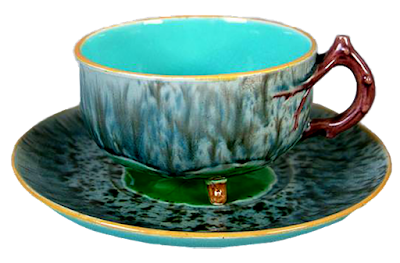When you consider the prodigious quantities that must have been produced during their heyday, there are relatively few majolica cups and saucers available today for the collector. It seems that only mustache cups, which were potted in much smaller quantities and received much less use than their regular c&s brethren, have survived to be collected today. We did a post about majolica mustache cups quite some time ago so I thought today we'd concentrate on regular cups and saucers.
Cups and saucers were produced by all the potteries, major and minor, that produced majolica. As you might guess, the most exquisite were produced by George Jones and Minton, often in creative designs to compliment the teapots they were made to match.
On the other side of the Atlantic, teacups and saucers were made by American firms as well.
The most famous of course would be the Shell cup & saucers made by the Etruscan Works but the company also made cups and saucers in other patterns as well.
Cups and saucers were produced by all the potteries, major and minor, that produced majolica. As you might guess, the most exquisite were produced by George Jones and Minton, often in creative designs to compliment the teapots they were made to match.
Minton majolica c&s
Minton pond lily majolica c&s
Minton majolica oak leaf luncheon set
George Jones majolica apple blossom c&s
George Jones majolica drum c&s
Minton majolica c+s
GJ majolica apple blossom c+s
Of course other companies like Wedgwood, Fielding and Holdcroft made cups and sauces as well as did other English companies. These too are very difficult to find, particularly some of the more delicate designs.
Wedgwood majolica St. Louis c&s
Wedgwood majolica Ocean c&s
Wedgwood majolica dragon cup & saucer
Holdcroft majolica coconut c&s
Fielding majolica c&s
Fielding majolica c&s
Shorter & Boulton majolica Fan c&s
Fielding majolica Ribbon c&s
Wardle majolica Chrysanthemum c&s
Wardle Bamboo c&s
Holdcroft apple blossom c&s
Addams & Bromley fruit c&s
Wardle majolica sunflower and lily c&s
Blackberry and basketweave c&s
Wardle/Lear majolica c&s
Forester majolica rose & rope c&s
Forester majolica flying crane c&s
The most famous of course would be the Shell cup & saucers made by the Etruscan Works but the company also made cups and saucers in other patterns as well.
Etruscan Majolica Shell c&s
Etruscan Majolica Cauliflower c&s
Etruscan Majolica Bamboo c&s
Etruscan Majolica Pandora c&s
The French, Portuguese and Germans made cups and saucers with some patterns still in production today.
Zell majolica grape and basketweave c&s
Sarreguemines majolica fruit c&s
Caldas majolica Palissy c&s
When buying cups and saucers you should always check the handle of the cup, which is the most fragile part of the teacup, for cracks or repairs. If you encounter them, it's also a good idea to buy individual cups without their saucers, because saucers are usually much more plentiful and easier to replace in a missing set.
Prices for tea cup sets are all over the place with some of the more elaborate sets running into the hundreds or thousands of dollars while others will only cost you about $50.
As always, do your homework and you're bound to get a fair price.
























































